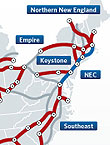President Obama has proposed spending $13 billion as a “first step” toward building a series of high-speed rail lines connecting major metropolitan areas in the United States. Among other places, the proposed lines — which would ultimately cost hundreds of billions to construct — would run from Washington to Boston; San Diego to San Francisco; Chicago to Minneapolis; Kansas City to Louisville, Ky.; Eugene, Ore. to Seattle, Wash.; Miami to Tampa, Fla.; and San Antonio, Texas to Tulsa, Okla. Obama said that $8 billion for the rail lines will come from his economic stimulus plan with another $5 billion to be allocated in the next several years. “High-speed rail is long overdue, and this plan lets American travelers know that they are not doomed to a future of long lines at the airports or jammed cars on the highways,” Obama said. California Gov. Arnold Schwarzenegger said his state hoped to receive a “significant portion” of the federal funds to help build a proposed $30 billion “bullet train” that would whisk travelers from Los Angeles to San Francisco in 2 hours.
Obama Unveils Major Spending For High-Speed Rail Network in the U.S.
More From E360
-
Biodiversity
As Jaguars Recover, Will the Border Wall Block Their U.S. Return?
-
WATER
An E.U. Plan to Slash Micropollutants in Wastewater Is Under Attack
-
INTERVIEW
This Data Scientist Sees Progress in the Climate Change Fight
-
Climate
As Floods Worsen, Pakistan Is the Epicenter of Climate Change
-
Climate
Heat Stress Is a Major Driver of India’s Kidney Disease Epidemic
-
Energy
It’s a ‘Golden Age’ for U.S. LNG Industry, But Climate Risks Loom
-
Climate
How Climate Risks Are Putting Home Insurance Out of Reach
-
INTERVIEW
Inside the Plastics Industry Playbook: Delay, Deny, and Distract
-
Biodiversity
Freeing Captive Bears from Armenia’s Backyards and Basements
-
Food & Agriculture
In Indonesia’s Rainforest, a Mega-Farm Project Is Plowing Ahead
-
FILM CONTEST WINNER
In the Yucatan, the High Cost of a Boom in Factory Hog Farms
-
INTERVIEW
In the Transition to Renewable Energy, China Is at a Crossroads
